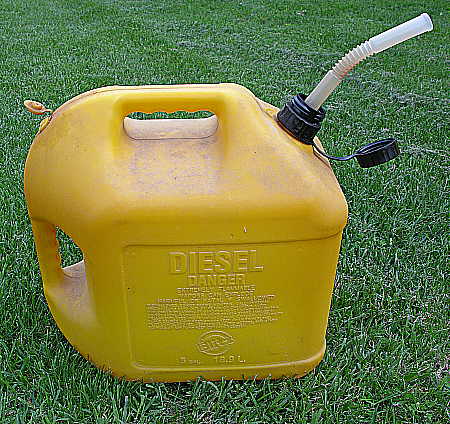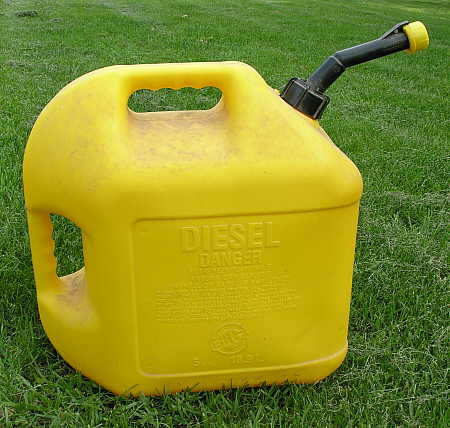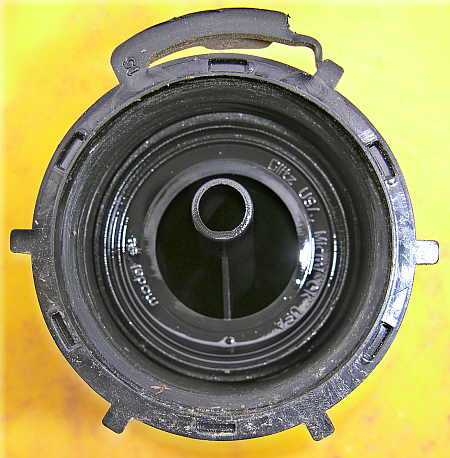
This is a picture of a five gallon diesel fuel canister that was purchased from Wal-Mart in 2001. There is nothing particularly special about this container, except for the fact that it is a mature and fairly well evolved product that has been sold across the continent for many years. You have probably used a canister like this one, or perhaps it’s red gasoline sibling, many times in the past. It is a useful and inexpensive product that has stood the test of time. When I open the spout assembly and begin pouring the fuel into my tractor’s fuel tank, it sounds something like this:
GLUB gla GLUB, GLUB gla GLUB, GLUB gla GLUB, GLUB gla GLUB, GLUB gla GLUB, GLUB gla GLUB, GLUB gla GLUB, GLUB gla GLUB, GLUB gla GLUB ……..
….. and so-on and so-forth until the canister is empty, which takes slightly less than two minutes.
Perhaps you remember a past post entitled The “Ouch” Factor that dealt with seeking an improved method of fueling my tractor, so as to minimize back strain. In that post, you can see a picture of this author fueling the tractor with a similar fuel container.Â

It is similar, but not identical to the canister in the first picture. If you compare the two containers, you will see that the second canister, purchased from the same Wal-Mart store in 2005, lacks a vent on the upper left-hand side of the container body. When I lift this container up and try to fill the tractor’s fuel tank, this is what I hear:
GLUB gla GLUB, GLUB gla GLUB, GLUB gla …. silence!
Remove the container from the filler neck, turn the canister upright to allow air back into the container to equalize the air pressure, lift the container back up to the filler neck, and begin the fueling operation:
GLUB gla GLUB, GLUB gla GLUB, GLUB gla …. silence!
Remove the container from the filler neck, turn the canister upright to allow air back into the container to equalize the air pressure, lift the container back up to the filler neck, and begin the fueling operation:
GLUB gla GLUB, GLUB gla GLUB, GLUB gla …. silence!
Remove the container from the filler neck, turn the canister upright to allow air back into the container to equalize the air pressure, lift the container back up to the filler neck, and begin the fueling operation:
You get the idea by now I hope!
It now takes me over 7 minutes to drain one of these new fuel containers, but worse than the time involved is the fact that I have to lift/lower the heavy fuel container repeatedly in order to accomplish this formerly simple task.
When I first used this fuel container and noticed that it wasn’t working the way I thought it should, my initial reaction was that the company must have inadvertently neglected to install a vent in the container’s body, as was included in the previous style.  But upon further examination I discovered the cause of the problem to be an ill-conceived and poorly executed attempt at including the vent mechanism within the actual spout itself. The following photo shows the underside of the new style spout:

In this photo you can clearly see a small vent tube molded within the larger fuel spout opening. I do not claim to have any special knowledge of hydrodynamics or hydraulic engineering, but it seems contrary to my intuition that this could possibly work. How can the fuel flowing through this spout possibly be offset by an equal airflow through a vent tube 1/5 the size of the fuel opening, particularly when the fuel surrounds the vent (top and bottom) while it is flowing?
Let us assume for a moment, just for the sake of argument, that the designer of this spout assembly drafted the concept in a CAD program, calculated the appropriate calculations necessary to arrive at a workable design that resembled what we see here. Wouldn’t somebody in the design team have looked at this and had the same intuitive sense about this design that I had, and nixed the design as unworkable, or at least ordered a prototype to be produced to test the concept? And if they had tested this hypothetical prototype, wouldn’t they have gotten the same results as I did?
Let us now move on to manufacturing. The tool and die makers create the molds necessary to produce the spout assemble, which they pass on to the shop floor. The molds are installed on an injection molding machine, and out pop spout assemblies by the score. At some point, doesn’t the shop foreman, his/her supervisor, the product manager, or the plant manager think to fill a container with water and see if the new spout assembly works? Are there no curious souls left? Does anybody care enough about the product they produce to try it out?
The factory, content in the fact that they have the injection moulding machines now spitting out spouts (no pun intended), provide samples and specifications to the marketing department, so now the ball is in their court.  Marketing is tasked to sell, and sell they do (obviously, as I purchased this canister at Wal-Mart). Did the marketing manager at this company, after spending long hours dreaming up wonderful prose extolling the virtues of this new fuel can model, ever have the desire to fill up one of these containers with an actual liquid, and try out the “New & Improved” spout? And how about the sales representative who flew to Bentonville, Arkansas to speak with the automotive buyer at Wal-Mart, carrying with him samples of his companies new fuel cans? This was the man/woman charged with the responsibility of knowing everything there is to know about his product, in order to accurately inform and educate the buyer about this item. Shouldn’t this person have once thought to actually put the fuel can through it’s paces?
The fact that I purchased this fuel canister at Wal-Mart indicates that the item passed whatever product screening the Wal-Mart buyers thought necessary for inclusion in the automotive department of the store. The operational specifications for a fuel container of this type should be fairly simple and straightforward. One should be able to fill it with liquid, and one should be able to pour out the liquid. Nothing should happen in between these two events. It is really that simple. Didn’t anyone on the buying staff at Wal-Mart think to perform even the simplest test of this item, particularly since they were aware of the re-design of the spout assembly?
Last, but not least in this unfortunate chain of neglect is the owner of the company that produced this fuel canister. I believe that Mr. Gates has an obligation to himself and his company to sit down in front of a Windows computer and use the software his company produces. Similarly, I believe that Mr. Ford has a duty to get behind the wheel of the automobiles that bear his family’s name. Along the same line of reasoning, I believe that it is also the responsibility of the owner of the fuel canister company that produced this item to have actually tried to use it, if even once.



I couldn’t agree with you more!
I have a similar plastic gas container, that has a similar ridiculous spout. In order to cause gas to flow, you have to press the spout into the fill hole, so that the hose/spout assembly retracts. Once it does retracts, gas flows and splashes like I’m filling an Indy car! There is no halfway – trying to fill a partially filled tank on the pressure washer ends up spilling more gas than the silly anti-fume assembly would save in fumes. And let’s think of the possibly inflammable lawsuits waiting in the wings resulting from those weekend warriors refilling gas tanks atop those red hot engines.
And on a cooler topic, the local hardware store has started selling garden accessories by an equally ridiculous manufacturer. I purchased a nose nozzle that actually rusts! What the heck! I suppose the fault was mine; my wife indicates I should not have used the accessory in a wet environment.
Sadly, I am guessing the reason for the change in design is that it allowed the manufacturer to reduce their production costs by $1 per thousand units, which allowed them to sell the product at the price that Walmart demanded.
I’m generally one to remain neutral in the great “Walmart” debate, as I can usually see merits in the arguments that all sides to the issues bring to the table. At some point however, one has to admit that the pressure Walmart applies to vendors to maintain a steady stream of cost reductions goes too far when the basic functionality of a product is defeated in order to cut costs.
What worries me about this trend is that some items we utilize everyday are produced by an increasingly smaller pool of manufacturers, many branding the (substantially) same item with a dozen different names. If all of the manufacturers are pressured to reduce costs to this degree by Walmart, soon we won’t be able to buy anything of quality from ANY source, as manufacturers cannot successfully maintain two sets of quality standards (one for Walmart and one for other retailers who want to maintain quality).
It has been interesting to see how the Walmart story has developed so rapidly over the past twenty years. It will also be interesting to see how the story plays out over the next twenty years.
Yes – yet another ludicrous invention produced by an overpaid, yet underqualified idiot! These people tend to believe their own un iversity degree somehow gives them design capabilities.
B.S. means just that!